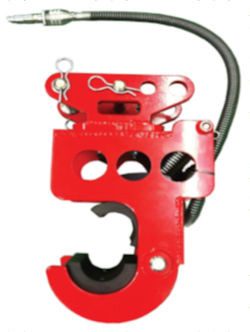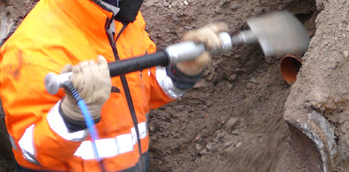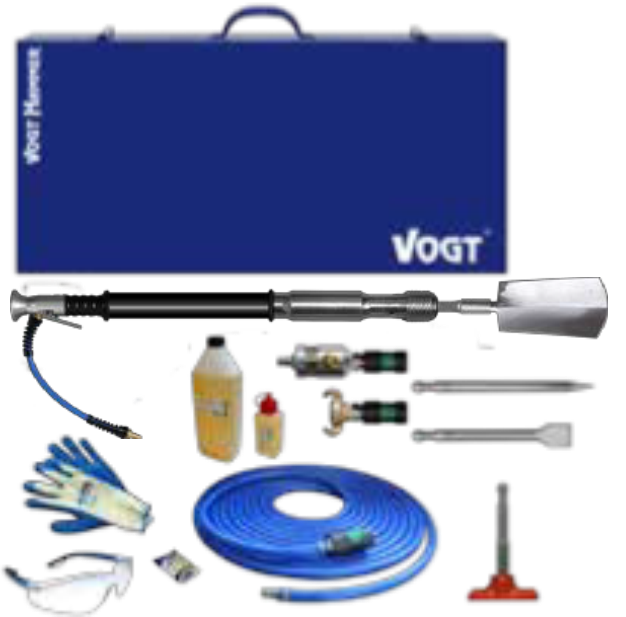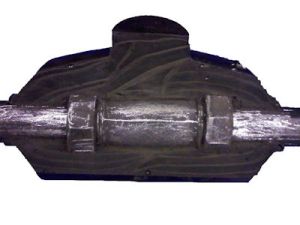c0bfe79547ef6d83db8f48f1543aca4d
Author: Energy Mac
c0bfe79547ef6d83db8f48f1543aca4d
c0bfe79547ef6d83db8f48f1543aca4d

Pushing or pulling new PE pipe into a host pipe using winches, slings on a backhoe bucket or plain brute strength is slow, labor-intensive, potentially dangerous and risks damage to the PE pipe.

New Way: The Pipe Handler easily grips and maneuvers the PE into the host pipe seamlessly without damage. The unit attaches to the end of an excavator’s arm and the entire operation is controlled from the cab. Inserting up to 33 feet of pipe per minute with lengths of 1,600 feet or more is now possible.
Workers never need to handle the pipe or enter the trench. Typical attachments handle 2″ through 6″ PE pipe.
Check out the video: Pipe Handler

Large Diameter PE Laterals: The Supraflow Solution
In the US, distribution companies add Polyethylene (PE) branch connections, services, and by-passes without dramatically restricting gas flow by using hot tapping equipment or installing 3-way tees by squeezing off the main. These current methods perform the job but have their disadvantages such as limited flow capacity, expensive equipment, complicated procedures, risking PE pipe stress cracking, large excavations and labor-intensive.
Current PE Lateral Installation Choices
3-Way Tee
Installing a 3-way tee provides no flow restriction. Although, the gas must be stopped using multiple squeeze-offs in order to fuse a 3-way tee in-line with the main. The squeeze-off procedure creates a few concerns with larger diameter PE pipes such as:
- Possible need to install a temporary bypass adding labor and material cost.
- Susceptible damage to existing PE pipe at the squeeze points, decreasing pipeline integrity.
- Large excavations are required which increases reinstatement cost.
- Very large squeeze-offs require lifting equipment to maneuver in place, adds to job site mobilization cost.
- Squeeze-off may not completely stop the gas, creating a dangerous work environment.
High-Volume Tapping Tee (HVTT)
The high-volume tapping tee (HVTT) with an Electrofusion (EF) saddle and a self-contained wind-down cutter are one of the easiest fittings to install a lateral connection. However, these tees are only available in 2” and smaller, restricting flow compacity for laterals requiring a high volume of gas. Also, HVTT typically does not have the installation flexibility to accommodate a variety of pipe configurations due to its preferred upright installation position.
PE Saddle Hot Tapping
Large PE lateral branches are most commonly installed by hot tapping through a 2”-8” fused branch saddle using specialized equipment. Some examples include the McElroy Hot Tap tool, T.D. Williamson SHORTSTOPP system and the M.T. Deason POLYTAPP. These systems require a lateral shut-off valve. The drill shaft and cutter travel through the valve to create the tap into the sidewall of the main. However, these procedures have many laborious steps to complete and typically performed by a specially trained crew. The method also requires a large excavation, adding expensive reinstatement costs. Once the tap is complete, the drill shaft is retracted, valve is closed and equipment is removed. Pipe connections are completed. Though, the connection between new pipe and valve cannot be air tested prior to energizing the new lateral. Since air testing against a live valve is typically against procedures, this method introduces an untested connection into the system.
Supraflow Tapping Tee
New to the USA, the Supraflow Tee is a fitting and tapping procedure for installing live 4”-8” branch connections gas-free at high pressure on large diameter PE gas mains without squeeze-offs or disrupting the gas flow. All can be done in a small 3′ x 3′ excavation. Solving many of the drawbacks inherent to the other methods outlined above.The Supraflow developed by Grupo Torre in Barcelona, Spain, around 2010 was in response to growing concerns in Europe over the lack of cost-efficient large diameter PE hot tapping systems. As well as safety issues over the potential damage that squeeze-off causes to PE pipes. Over 9,000 Supraflow tees have been installed in Europe for outlet diameters of 90 mm-160 mm (3”-6”). In recent years, a few major gas utilities in the US, such as CenterPoint Energy have begun to use the tee for branch connections up to 8″ diameters.
The Supraflow fitting can be used with any currently approved branch saddle fitting, making it easily compatible with any company’s pipeline system. It is an intrinsically safe solution for main connections, high flow services and large diameter by-pass installations for 4”-8” branching on 4”-18” PE mains operating up to 150 psi. Tapping is simple and quick using Supraflow’s ultra-light drilling equipment. Its exclusive tubular cutter retains the coupon and shavings preventing them from entering the main. The Supraflow is as easy to install as a HVTT, without restricting flow and without the hassle of complicated equipment or squeezing off. The fitting saves money and enhances safety when expanding the PE system with large PE branch connections.

TurboSpade Pneumatic Digging Tool
Some days you get the bear and some days the bear gets you. This popular expression describes the physical toll a typical gas utility worker endures every day by working outside in the elements. Routine tasks such as shoveling, bar holing, or lifting heavy equipment dramatically put the body at risk for injuries. According to a Pipeline and Gas Journal article, many injuries reported are not catastrophic one-time occurrences but instead may occur, with repetition and overexertion, over several years. Strain or sprain injuries accounted for 43.6% of all reported injuries for local distribution companies. Gas worker injury statistics indicate that each time an individual files a lost-time injury claim; it costs the utility between $20,000 and $30,000. Additionally, these types of injuries often occur to the most common group of field personnel. The average age of an injured worker is 38, and the 31 to 40 age group experienced more injuries than any other group surveyed. The cost to recruit and train replacements can be significant, and both work quality and productivity suffer.
According to the Bureau of Labor Statistics, more than one million workers suffer back injuries each year. Preventing back injuries will always be a challenge. However, in a recent study, it was determined that up to one-third of back injuries could be prevented through better job design (ergonomics). Equipment design can have a significant impact on decreasing everyday pain many field workers experiences, as well as the long-term injuries that curtail productivity and pull experienced workers out of the field.

Excavation is often the largest cost for most projects and losing workers due to a work-related injury is an even larger cost. The TurboSpade offered by PLCS is an ergonomic pneumatic tool that may help decrease work-related strains or back injuries when performing the daily repetitive task of digging in a keyhole or traditional excavations. The ultra-lightweight tool weighs about 13 lbs for the most common model, which is at least 43% lighter than most tools in its class. The robust TurboSpade, constructed with a special plastic frost-proof body, uses a low consumption of air to produce a high percussion of power with less vibration. The tool is armed with a variety of quick-change bits to loosen difficult earth, break concrete, rock, asphalt or frozen ground. The TurboSpade may be one tool to add to the digging arsenal to increase excavation production and to decrease injury claims, keeping workers healthy and injury-free.
 Do you have a lot of ¾”-2” steel main running at a maximum of 60 psi put together using barrel nut type couplings?
Do you have a lot of ¾”-2” steel main running at a maximum of 60 psi put together using barrel nut type couplings?
The Compression Coupling Encapsulation is a plastic mold system that permanently seals 3/4” to 2” metallic compression type couplings (i.e. NORMAC, Dresser Style 90).
 The system seals compression couplings by first tightening the nuts to stop the leak and filling a plastic mold with our standard Series 6, which has been used all over the world at pressures up to 60psi for 30+ years. It is the only sealant that has passed British Gas LC8 specification (the toughest in the world) and the Cornell University/Wyle Labs tests for the New York Gas Group. Both specifications are meant to extrapolate to minimum in-ground use of 50 years under all known gas pipe and soil conditions.
The system seals compression couplings by first tightening the nuts to stop the leak and filling a plastic mold with our standard Series 6, which has been used all over the world at pressures up to 60psi for 30+ years. It is the only sealant that has passed British Gas LC8 specification (the toughest in the world) and the Cornell University/Wyle Labs tests for the New York Gas Group. Both specifications are meant to extrapolate to minimum in-ground use of 50 years under all known gas pipe and soil conditions.
There are 2 different size kits (in stock).

(1) #01-750 ¾”-1-1/4” kits include the sealant, necessary components, and gaskets to accommodate ¾”, 1”, and 1-1/4” couplings.
(2) #01-752 2”-1 ½” kits include the sealant, necessary components, and gaskets to accommodate 2” and 1-1/2” couplings.
A few companies using this method of encapsulation by the 1000’s:
- Washington Gas- Since 2005 has purchased about 12,000+ of these repair kits with 100% success and has saved many $millions from their original estimation of $144 million to replace all the couplings. Their initial experience with the Compression Coupling Encapsulation is outlined in the attached document
- PSE&G – NJ
- Memphis Light Gas & Water, TN
